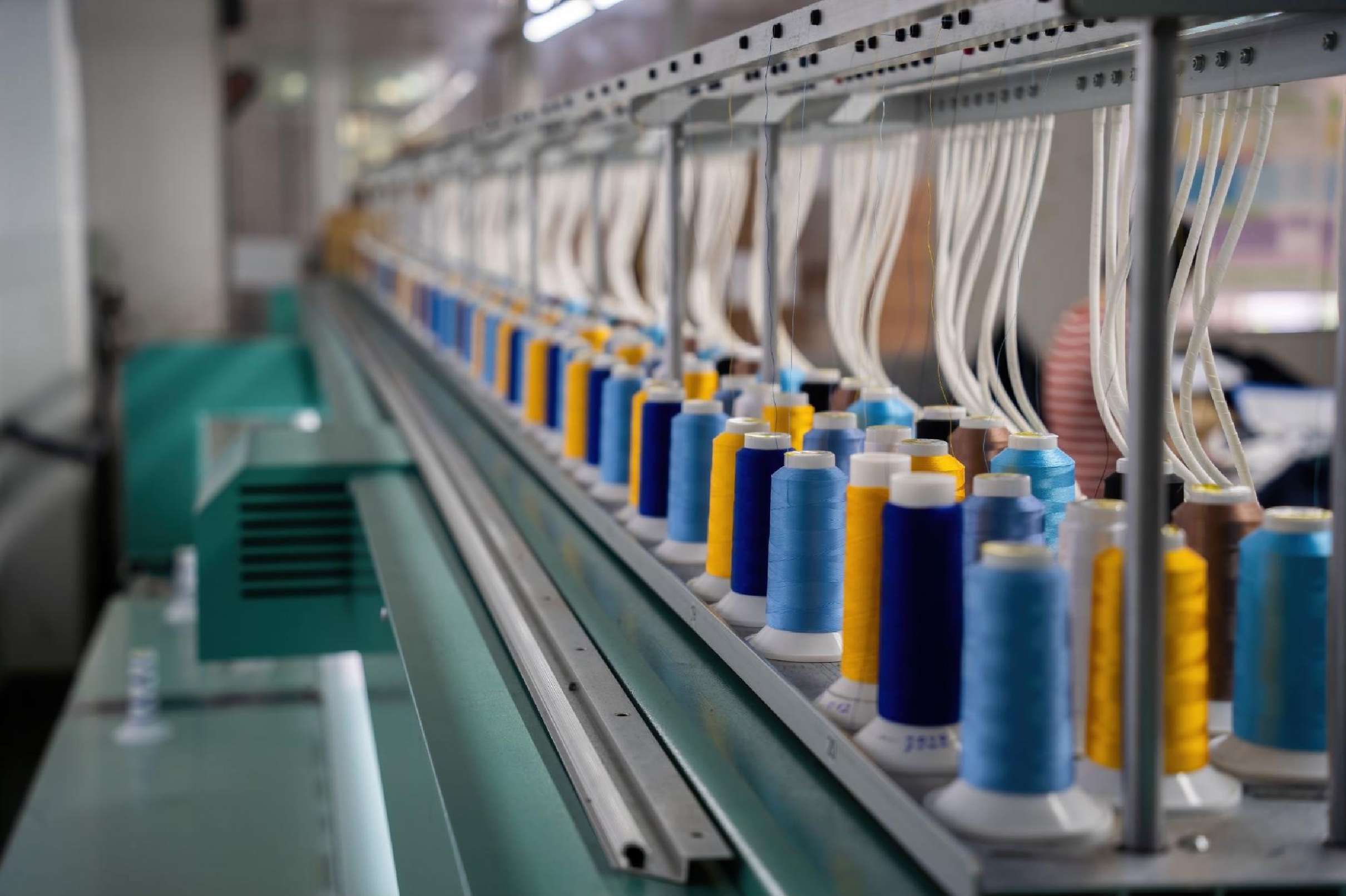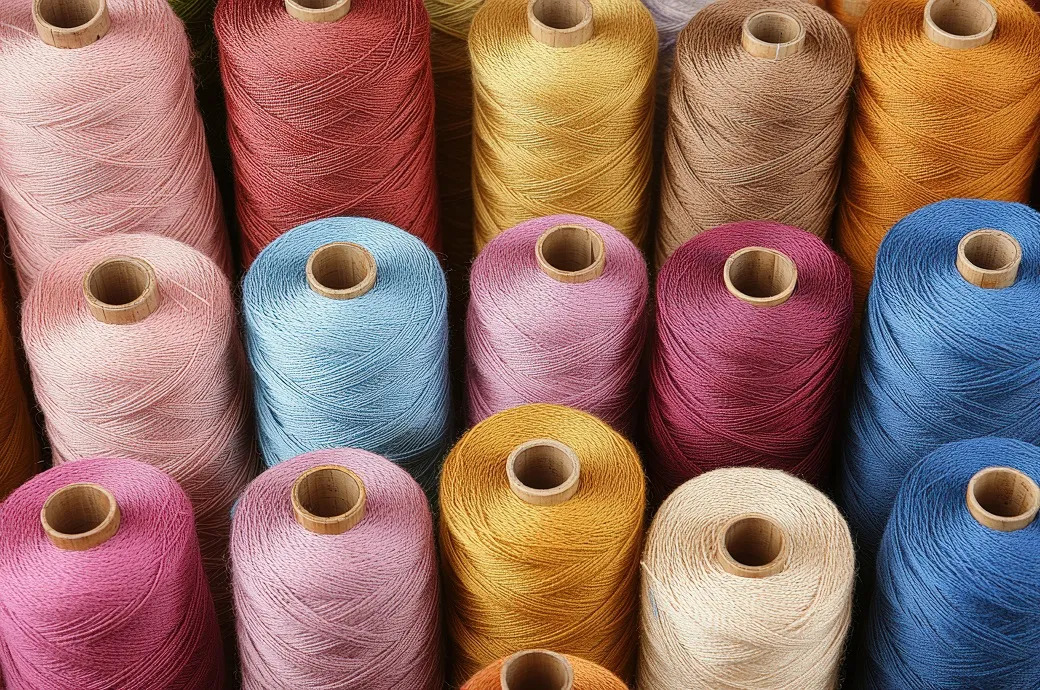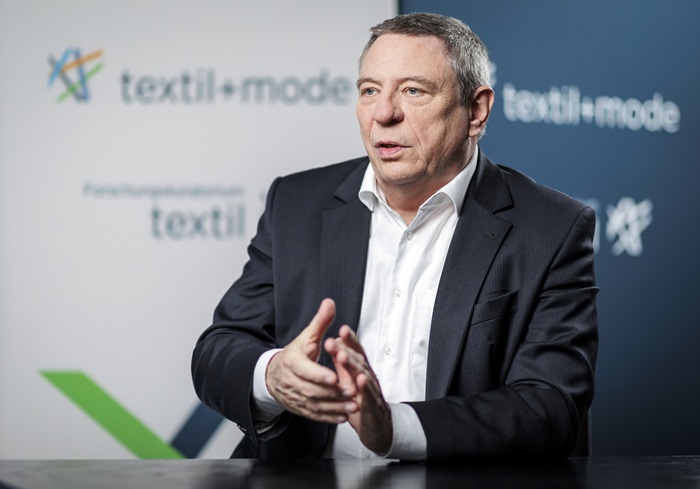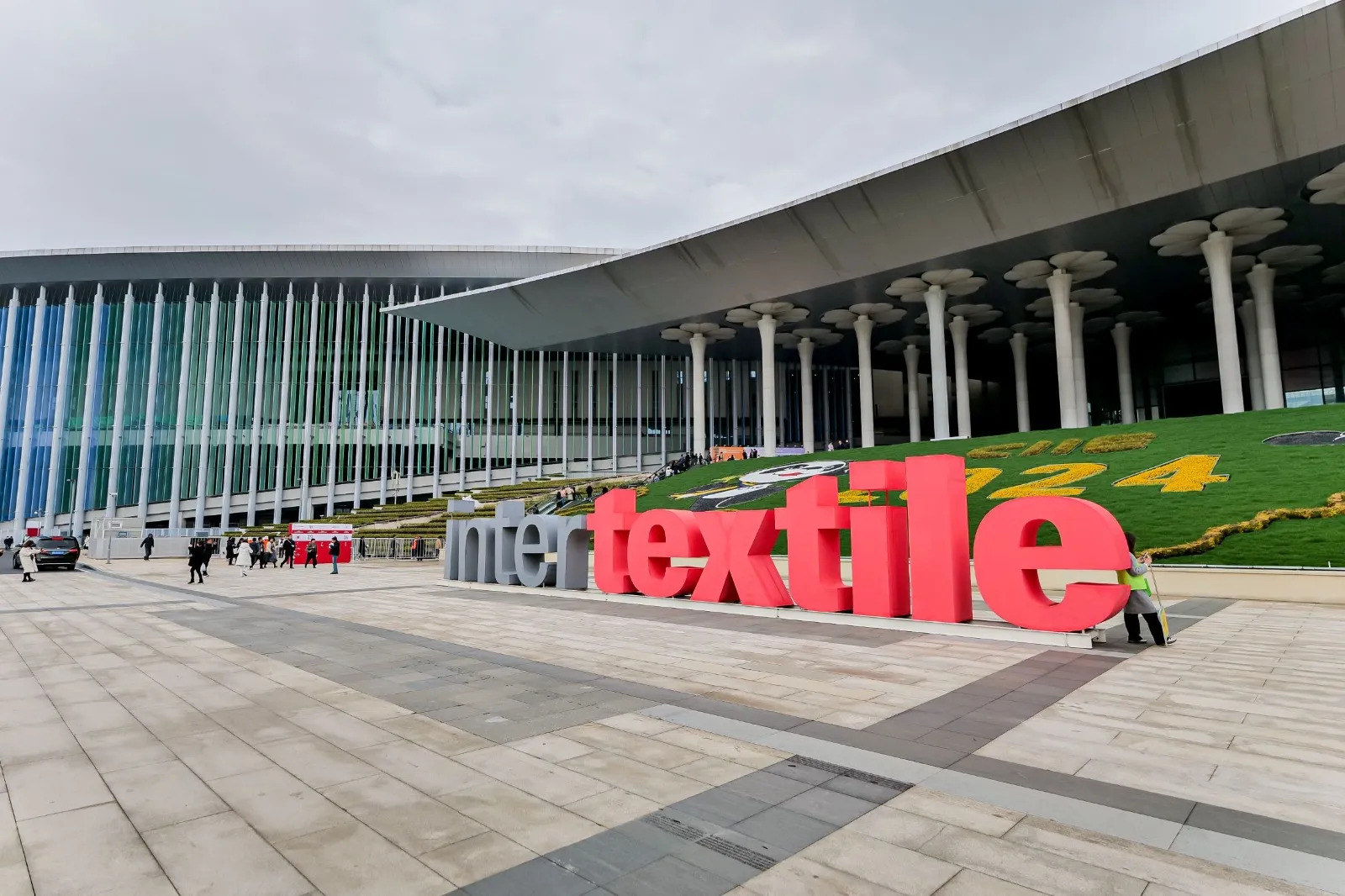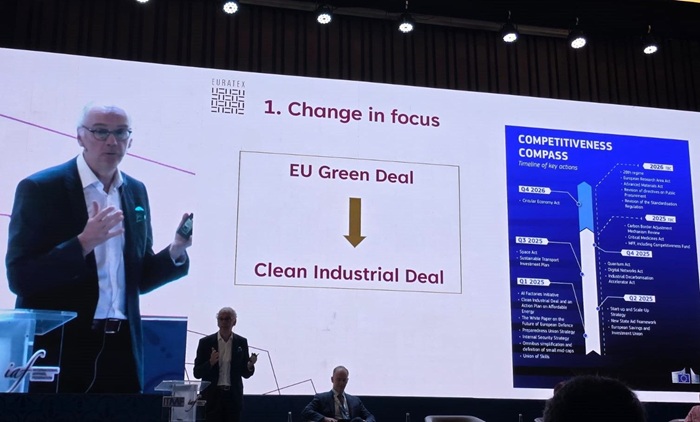FW
Hugo Boss is launching an innovative recycled polyester yarn, ‘NovaPoly,’ co-developed with its suppliers Jairen Chemical Recycling and NBC LCC.
Hugo Boss holds the trademark and exclusive usage rights for this yarn for the first year. As a part of its ‘Boss The Change’ initiative, the company will launch the first Boss Green products featuring NovaPoly globally in October 2025. The yarn will be licensed across the broader fashion sector in the future.
While initially available exclusively for the Boss and Hugo brands, the company is actively developing a licensing model to make this innovative fiber accessible to a wider range of industry partners going forward. NovaPoly is manufactured using textile waste collected from both clothing production and post-consumer sources. It includes a natural additive designed to mimic the natural behavior of fibers in the environment, making it degradable. This innovation is a key component of Hugo Boss’ strategic goal to combat microplastics, a central pillar of the company’s sustainability strategy. NovaPoly complements the brand’s existing efforts to develop alternatives to traditional polyester and polyamide fibers, building on previous collaborations like the partnership with HeiQ AeoniQ.
Products incorporating NovaPoly will be available online, in Boss stores, and at select wholesale retail partners worldwide beginning in October 2025. As part of the Spring/Summer 2026 collection for Boss Green, the yarn will be integrated into specific performance wear pieces.
An investment platform established by British International Investment (BII), Growth Investment Partners (GIP) has made significant investments in the Ghana-based garment manufacturing company, Maagrace Garments Industries (MGIL) to construct a new state-of-the-art production facility at MGIL existing premises in Koforidua.
This expansion project will help boost Ghana's position in the global apparel industry by substantially increasing production capacity, expanding export volumes, and generating employment opportunities on a large scale, particularly for women and young people.
Jacob Kholi, Chief Executive and Investment Officer, GIP Ghana, avers, this project will serve as a testament to Ghana's industrial potential and its capability to compete globally in ethical garment manufacturing. MGIL's proven success in creating jobs, especially for women, while simultaneously driving export growth, perfectly aligns with our mission to support scalable and inclusive businesses, he adds.
Keren Pybus, Co-Founder and CEO, Ethical Apparel Africa (EAA), notes, this investment significantly supports the company’s vision of building a world-class garment industry in Ghana – one that raises the standard for ethical manufacturing, champions women's empowerment, and demonstrates strong environmental responsibility.
A subsidiary of Ethical Apparel Africa (EAA), an apparel sourcing and manufacturing firm headquartered in the United Kingdom, MGIL employs over 700 direct workers, with women making up 72 per cent of its workforce. The company is a major exporter, shipping over 90 per cent of its products to prominent international brands primarily based in the United States, the United Kingdom, and Europe.
Since acquiring MGIL, EAA has made substantial investments in technologies designed to enhance productivity. These include the implementation of solar power systems, digital pattern software, smart metal detection equipment, and a custom enterprise resource planning (ERP) platform. These technological upgrades have notably doubled productivity at the facility and facilitated the successful transfer of advanced technical skills to local middle managers.
Driven by a strong social mission, EAA aims to create over 10,000 quality manufacturing jobs across West Africa by 2030. The company is also dedicated to shaping the emerging apparel ecosystem in the region to prioritize the well-being of people and the protection of the planet.
The expansion project is expected to more than double the existing production capacity through the installation of new manufacturing equipment and the addition of crucial warehousing space.
In a major push for India's textile sector, the Union Government has concluded a landmark Free Trade Agreement (FTA) with the United Kingdom, eliminating tariff barriers on key textile products. The move is expected to significantly boost exports, particularly garments and made-ups, which earlier faced duties of 10 per cent to 12 per cent, while yarns and fabrics saw levies of 4 per cent to 8 per cent.
S K Sundararaman, Chairman of The Southern India Mills Association (SIMA), hailed the FTA as a ‘historic’ step, expressing gratitude to Prime Minister Narendra Modi and Union Ministers Piyush Goyal and Giriraj Singh for their efforts. He highlighted that India’s textile and clothing exports to the UK had declined from $2,370 million in 2017-18 to $2,119 million in 2024-25 due to tariff disadvantages. With the FTA, exports are poised for a turnaround, especially in segments like ready-made garments, which constitute around 70 per cent of India’s textile exports to the UK.
The UK, being the second-largest market for Indian garments, offers vast growth potential. Industry stakeholders believe this zero-duty access will help revive struggling sectors such as home textiles from clusters like Karur, which have faced stiff competition from countries like Pakistan.
The government has set an ambitious target to grow the Indian textile industry from $165 billion to $350 billion by 2030, with exports rising to $100 billion. The FTA is expected to attract $100 billion in new investments and create 10 million jobs over the next five years. The zero-duty regime is also expected to enhance the success of PM MITRA Parks, PLI, and NTTM schemes, helping India tap into its surplus capacity and elevate its global competitiveness.
The Apparel Export Promotion Council (AEPC) has hailed the India-UK free trade agreement as a game-changing development for the ready-made garment (RMG) sector. AEPC Chairman Sudhir Sekhri called the deal a ‘landmark’ move that will enhance India's competitiveness in the UK market by immediately eliminating the existing 9.6 per cent tariff disadvantage.
“This FTA comes at a critical time when global trade is impacted by demand contraction, the Russia-Ukraine conflict, Israel-Hamas war, American tariff actions, and Chinese assertiveness,” Sekhri said. “With this deal, ‘Made in India’ garments will now be more affordable on UK shelves, bringing us at par with major competitors already enjoying duty-free access.”
Sekhri expressed gratitude to Prime Minister Narendra Modi for his leadership and to Union Commerce Minister Piyush Goyal for pushing the deal to fruition.
India is currently the fourth-largest RMG supplier to the UK, holding a 6.1 per cent market share. RMG exports to the UK grew 7.8 per cent during April-March 2024-25 compared to the previous year, reaching $1.4 billion. With the FTA now in effect, AEPC expects exports to double within the next three years.
In 2024, China led UK’s RMG imports with a 25.4 per cent share, followed by Bangladesh (19.9 per cent) and Turkey (7.9 per cent). India’s top RMG exports to the UK include cotton T-shirts, women’s dresses, and baby garments.
Sekhri added that the deal opens up significant opportunities, leveraging the complementary strengths of both economies and offering Indian exporters a strong competitive edge.

Forget the image of mountains of discarded clothing polluting landfills. A new white paper by Bank & Vogue Ltd/Ltée reveals the vast majority of secondhand textiles find new life through a complex global network of reuse, resale, and recycling. The report, ‘Beyond the Landfill Myth: Mapping the True Journey of Secondhand Clothing’, challenges common misconceptions and gives a data-driven analysis of the secondhand clothing trade, highlighting its significant economic and environmental contributions.
Majority of secondhand clothes reused, recycled
The white paper's central finding directly contradicts the prevailing narrative. "The common narrative suggests that much of the world's used clothing ends up in landfills," the report states. However, the report paints a different picture. As per Global Fashion Agenda (2023), approximately 73 per cent of globally collected secondhand clothes are reused or recycled. This figure underscores the substantial role of the secondhand sector in diverting textiles from landfills and leading to a circular economy.
Global journey of your donated t-shirt
So, what actually happens to your donated clothes? The report traces the intricate paths of used textiles across international borders.
• Export hubs: The US, Canada, Germany, and the UK emerge as top exporters of secondhand clothing.
• Import destinations: Pakistan, Ghana, Kenya, Chile, and India are identified as major importers, showing the global demand for affordable secondhand garments.
• Local sorting and reuse: Upon arrival in recipient countries, local businesses play a crucial role in sorting and categorizing the influx of clothing. Sellable items are introduced into local resale markets, providing affordable clothing options for communities. Unsellable items are not discarded but find new purpose through upcycling or repurposing, transformed into products like industrial cloths or mattress stuffing.
Secondhand markets as economic engines
The white paper looks at specific case studies that illustrate the profound impact of the secondhand clothing trade on local economies:
• Kantamanto Market, Accra, Ghana: Described as one of the largest secondhand clothing hubs in West Africa, Kantamanto Market employs over 30,000 people. The market facilitates the repurposing of millions of garments weekly, with initiatives like The OR Foundation supporting local tailors and upcyclers in maximizing textile reuse.
• Iquique Free Trade Zone, Chile: Chile imports significant volumes of used clothing, exceeding 59,000 tons annually. Local resale markets and recycling companies ensure these clothes are sorted and resold across Latin America. Notably, some organizations are pioneering recycling solutions to address textile waste in the Atacama Desert.
• Panipat, India: Panipat has carved a niche for itself in wool recycling. The city receives worn textiles from Western countries, which are then shredded and re-spun into yarn. This recycled yarn is used to produce affordable blankets and garments for both domestic and international markets.
Beyond waste diversion
The report emphasizes that the benefits of the secondhand clothing trade extend far beyond simply reducing landfill waste.
• Waste reduction: Extending the life of clothing has a significant positive environmental impact. WRAP research indicates that increasing the lifespan of clothes by just nine months can reduce carbon, water, and waste footprints by 20-30 per cent.
• Employment generation: The secondhand economy is a major source of employment worldwide. It sustains livelihoods for tailors, sorters, transporters, and sellers in developing nations, as well as warehouse and logistics workers in exporting countries.
• Circular economy alignment: Organizations like SMART and the European Recycling Industries' Confederation (EuRIC) advocate for the integration of secondhand clothing into circular economy strategies. Research confirms that textile reuse offers the lowest environmental impact compared to both recycling and landfilling.
Charting the path forward
While the white paper highlights the successes of the secondhand clothing trade, it also acknowledges existing challenges. Overconsumption is an issue that contributes to oversupply of used clothing, creating logistical and management pressures. Also, limited infrastructure for local textile recycling in some regions hinders the ability to process unsellable items effectively. Regulatory pressures, such as import bans in certain East African countries, can disrupt the flow of secondhand clothing and limit its economic benefits.
Thus to optimize the secondhand clothing sector and increase its positive impact, the report offers several recommendations.
• Improved sorting: Enhancing donation sorting at the source can significantly reduce the volume of unusable items, streamlining the process and minimizing waste.
• Investment in infrastructure: Investing in local upcycling and recycling infrastructure is crucial for maximizing the reuse potential of textiles within recipient countries.
• Education and awareness: Educating consumers and governments about the true lifecycle of clothing is essential for fostering responsible consumption habits and supporting sustainable policies.
The Bank & Vogue Ltd/Ltée white paper offers a compelling argument for recognizing the secondhand clothing trade as a vital component of the global economy and a key driver of sustainability. By debunking the landfill myth and highlighting the industry's capacity for reuse, resale, and recycling, the report advocates for investing in its optimization rather than discarding or restricting it. This strategic approach can unlock the full potential of secondhand clothing to contribute to a more circular and sustainable future.

The just concluded Free Trade Agreement (FTA) between India and the UK, a culmination of over three years of negotiations, will significantly impact India's fashion and apparel market. While it aims to boost trade and strengthen strategic partnership between the two, its implications for domestic consumption patterns, the entry of UK brands, and the flow of apparel imports into India warrants a closer examination.
FTA overview
The India-UK FTA is a comprehensive trade agreement designed to foster closer economic ties. Key provisions include
• Tariff reductions: The UK will eliminate tariffs on Indian textile and apparel imports. India, in turn, will reduce tariffs on several UK exports.
• Social security and visa provisions: The FTA also includes agreements on social security contributions for Indian workers in the UK and streamlined visa processes for business travel.
• Economic impact: The UK government estimates a substantial boost to its economy. For India, the FTA is expected to enhance trade, attract investment, and create jobs.
Impact on Indian fashion and apparel market
As per UK Department for Business & Trade, 2024 statistics, pre-FTA, UK tariffs on Indian apparel was 4 to 12 per cent; post-FTA it will be 0 per cent on 99 per cent of Indian exports. It will impact Indian garments which will be 8-10 per cent cheaper, boosting demand for cotton merchandise and home textiles. As of 2024 India holds 5.6 per cent share of UK’s apparel imports, which is £3.2 billion and by 2030 the target is to have 12 per cent share or £4.35 billion. The FTA's influence on the Indian fashion and apparel market can be viewed from several angles.
Increased competition and consumer choice: It is likely to encourage more UK fashion brands to enter the Indian market. This could lead to greater choice for Indian consumers, with access to a wider variety of styles, trends, and price points.
Imports of fashion & apparel: Reduced tariffs could make UK apparel imports more competitive in India. This may lead to a rise in import of UK fashion products, potentially affecting domestic apparel manufacturers.
Opportunities for Indian retailers and brands: While increased competition is a factor, the FTA also presents opportunities for Indian retailers and brands. They can leverage the agreement to source high-quality UK fabrics and accessories at more competitive prices; collaborate with UK designers and brands to bring innovative products to the Indian market; expand their own export operations to the UK, taking advantage of the reduced tariffs.
Shift in consumer preferences: Exposure to UK fashion trends and brands could influence consumer preferences in India. This will lead to greater demand for western wear and contemporary styles and high-quality branded apparels. Also, sustainable and ethically produced fashion will increase.
Table: India and UK bilateral trade in textiles, apparel, and fashion
|
Year |
India exports to UK (in $) |
India imports from UK (in in $) |
|
2021 |
1384.35 |
6.74 |
|
2022 |
1420.01 |
3.68 |
|
2023 |
1385.35 |
4.02 |
Note: Data is sourced from the Department for Business and Trade, United Kingdom and Trading Economics.
In the above table, apparel and textile category includes articles of apparel, not knit or crocheted; articles of apparel, knit or crocheted; Other made up textile articles; special woven or tufted fabric, lace, tapestry.
Textiles and apparel imports into India and FTA’s impact
While India is a major exporter of textiles and apparel, there is also a flow of imports, including those from the UK. Historically, India's imports of textiles and apparel from the UK have been relatively small compared to its exports to the UK. This is due to factors, like India's strong domestic textile industry and cost competitiveness in many segments. However, the UK is known for its high-value, premium fashion, and specialized textiles. India's imports from the UK may include high-end fashion apparel from UK luxury brands; specialized textiles, such as fine fabrics, niche materials, or technical textiles used in specific applications; designer wear and exclusive fashion items.
The FTA's tariff reductions are likely to make UK textile and apparel imports more price-competitive in India. This could lead to a gradual increase in imports, particularly in categories where UK brands have a strong reputation or where UK products offer unique value. Increased imports may affect domestic manufacturers, especially those competing in similar product segments. However, it could also stimulate them to improve quality, design, and innovation to stay competitive. Indian consumers will benefit from a wider range of choices and potentially lower prices on UK fashion brands.
Impact on domestic manufacturers
The FTA presents both challenges and opportunities for Indian apparel manufacturers. While increased competition from UK brands, especially in the premium and luxury segments, could put pressure on domestic players. The FTA can help Indian manufacturers access cheaper raw materials from the UK and integrate into global supply chains. Exports to the UK will also get a boost as UK retailers like M&S, ASOS among others are diversifying away from China.
Thus the India-UK FTA is expected to reshape the Indian fashion and apparel industry. While increased competition from UK brands and imports is a likely outcome, the agreement also offers significant opportunities for Indian manufacturers and retailers to increase their reach, upgrade their capabilities, and integrate into the global fashion market. The ultimate impact will depend on how Indian businesses adapt to the changing landscape and leverage the opportunities presented by the FTA.
Sudhir Sekhri, Chairman, AEPC opines, the landmark free trade agreement between India and the UK is expected to boost India’s RMG exports and help it generate new employment. Signed against the backdrop of demand contraction in major economies, Russia-Ukraine conflict, Israel-Hamas war, American reciprocal tariff and Chinese belligerence, the deal proves as a boon making India more competitive in the UK market. The FTA makes ‘Made in India’ RMG cheaper in the UK and brings it on par with some of its major competitors who enjoyed duty-free access in the UK market, he adds.
Thanking Narender Modi, Prime Minister for his visionary leadership and Piyush Goel, Union Commerce Minister for the relentless effort in concluding the deal, Sekhri notes, with a 6.1 per cent share in the UK’s total RMG imports, India is the fourth largest supplier of garments. RMG exports to the UK from India grew by 7.8 per cent between April – March 2024-25 compared to April March 2023-24. The total RMG exports to the UK amounted to $1.4 billion during the same period. With this deal in place, India is all poised to double the RMG exports to the UK in the next three years, he adds.
China remained the top supplier of RMG to the UK with 25.4 per cent share in 2024. Bangladesh and Turkey have a share of 19.9 per cent and 7.9 per cent, respectively. The top products imported by UK from India includes: (i) T-shirts, singlets and other vests of cotton, knitted or crocheted; (ii) Women's or girls' dresses of cotton; (iii) Babies' garments and clothing accessories of cotton, knitted or crocheted, informs Sekhri.
Huge opportunities offered by this deal coupled with the complementary nature of two economies and synergy across sectors will help in rapid growth and expansion of apparel business by providing competitive edge over our competing countries, notes Sekhri.
Welcoming the treaty, the Indian textile industry terms the India-UK Free Trade Agreement (FTA) as a significant step toward increasing India's presence in the UK market.
The agreement will help unlock new opportunities for exporters, boosting trade, employment, and global competitiveness, opine experts
Santosh Katariya, President, Clothing Manufacturers Association of India (CMAI), notes, UK is a growing and promising market for Indian textile and apparel products.
Recent tariff developments in the US highlight the need to diversify export destinations, making this FTA especially timely, he points out.
There is a strong need to diversify textile exports, and this FTA agreement will help knitted and woven apparel from India boost share in the UK market, adds Katariya.
An emphasis on sustainability, quality, and digital marketing with reduced prices will help Indian brands for UK consumers, he notes.
Experts opine, reduced tariffs under this FTA will drive demand for Indian textiles in the UK, resulting in increased export volumes.
The agreement will help stimulate investment and enhance the ease of doing business for textile stakeholders in both countries, they add.
Thanking Prime Minister Narendra Modi and Union Commerce Minister Piyush Goyal for their instrumental roles in securing this historic trade pact, A. Sakthivel, Vice Chairman, Apparel Export Promotion Council (AEPC), said, this monumental achievement will provide a strong boost to India's textile exports and fuel employment and growth in the sector.
The FTA will pave the way for long-term growth, attract investment, and create a more favorable business environment for textile stakeholders in both countries, he added.
The India-UK FTA marks the beginning of a new era for Indian textiles, with long-term benefits anticipated in market access, innovation, and global branding, industry leaders opine.
The Q1, FY25 profit margins of sportswear giant Puma declined and the brand reported flat sales as it focused on cutting costs and boosting overall performance.
Surpassing analysts’ projections of €2.041 billion, the brand’s sales increased by 0.1 per cent Y-o-Y to €2.076 billion (around $2.35 billion), during the quarter. However, softer demand from retailers in key markets like the US and China resulted in a 3.6 per cent decline in the brand’s revenue from the wholesale segment.
Currently undergoing a leadership change, the brand named Arthur Hoeld, former Sales Executive, Adidas as its new CEO. Hoeld will officially step into the role on July 1. In the meantime, Puma’s board is overseeing operations following Arne Freundt’s resignation on April 11.
Despite the ongoing challenges, Puma maintained its 2025 outlook, projecting ‘low- to mid-single-digit’ sales growth. However, the forecast does not include any potential impact from U.S. tariffs.
A premier shopping complex managed by Tilal Development Company, Muscat Grand Mall has introduced a new concept, ‘Little India’ in partnership with SRED.
Set up as a specific cultural and retail area, the concept showcases Indian fashion, lifestyle, food, and heritage in Oman. It is being presented as a jumping-off point for Indian brands entering the Gulf Cooperation Council (GCC) market,
As announced by the Tilal Development Company, the concept, Little India aims to link businesses with Omani shoppers and visitors looking for genuine and diverse retail options. The project is also designed to serve the large Indian population residing in the vicinity.
Ali Hosni, CEO and General Manager, Muscat Grand Mall says, with Little India, the retailer builds a strong connection between India and the GCC. It provides an opportunity to Indian brands join a regional success story, supported by consistent foot traffic, top-notch facilities, and a growing consumer base here in Oman, he adds.
The initiative will provide Indian fashion labels and artisan ventures with a purpose-built space inside Muscat Grand Mall, backed by leasing options and targeted marketing support. The so ial system has been created to support the substantial Indian community in Oman and the wider Gulf region, adds Sriram PM Monga, Co-founder, SRED.

